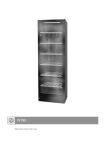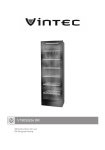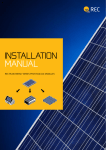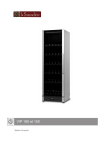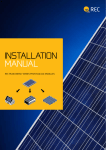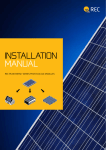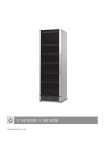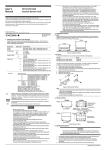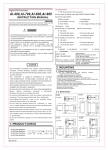Download Smeg SW Range Instruction Manual
Transcript
SW ... R UKInstructions for use DEBedienungsanleitung FR Mode d’emploi NL Gebruiksaanwijzing ES Instrucciones para el uso GB to the local distributor before the refrigerator is put to use. Thank you for purchasing your new refrigerator from Smeg. Please note that these instructions apply to all refrigerators in the SW range. Illustrations and fittings may therefore not necessarily correspond exactly to your model. Remove the packaging. Clean the inside of the cabinet using warm water with a mild detergent. Rinse with clean water and dry thoroughly (see cleaning instructions). Use a soft cloth. Warning As the refrigerant used in this appliance is a flammable gas (Isobutane R600a), special care must be taken to prevent damage to the refrigerant circuit and piping during transport and installation. If during transport the appliance has been laid down, or if it has been stored in cold surroundings (colder than +5°C), it must be allowed to stabilise in an upright position for at least an hour before being switched on. If damage does occur, avoid sparks or naked flame in the vicinity of the appliance, ensure that the room is well ventilated, disconnect the power supply, and contact your supplier. Contents Get to know your refrigerator............3 Installation and start-up....................4 Reversing the door...........................7 Electrical connection.........................8 Operation and function.....................9 Layout and fittings..........................10 Defrosting, cleaning and maintenance..............11 Fault finding....................................12 Spare parts and service.................13 Disposal..........................................14 The unit must only be serviced by qualified technicians from an approved service centre. Old appliances Old refrigerators and freezers are often fitted with complicated latches that can only be opened from the outside. If you have one of these old units stored away somewhere, or if you scrap one, remember to destroy the latch first in order to prevent children from being exposed to great danger by getting locked inside the unit. Before use Before operating your new appliance, please read the following instructions carefully as they contain important information on safety, installation, operation and maintenance. Keep the instructions for future reference. On receipt, check to ensure that the appliance has not been damaged during transport. Transport damage should be reported 2 GB Get to know your refrigerator Control panel Lighting Bottle rack Nameplate Shelf with storage boxes Door shelf Glass shelf Sealing strip Door handle Crisper bins Kick plate Adjustable feet fig.1 3 GB Installation and start-up Placement 600 600 For safety and operational reasons, the appliance must not be installed outdoors. 600 600 The appliance should be placed on a level surface in a dry, well ventilated room (max. 75% relative air humidity). Never place the appliance close to sources of heat such as cookers or radiators, and avoid placing it in direct sunlight. Room temperature The climate class is stated on the nameplate (see fig. 1 on page 3 and fig. 17 on page 13). This specifies the optimum room temperature. Climate class Optimum room temperature SN +10 ºC to +32 ºC N +16 ºC to +32 ºC ST +18 ºC to600+38 ºC T +18 ºC to +43 ºC fig. 2 600 Installation The surface on which the appliance is to be placed must be level. Do not use a frame or similar. The appliance can be installed as a freestanding unit against a wall, built into a kitchen element, or lined up with other appliances (figs 2-3). After installation, the plug should be accessible. fig. 3 4 GB The appliance viewed from above Distance pieces The distance pieces on the rear of the appliance ensure sufficient air circulation. Fit the distance pieces supplied with the appliance as shown in fig. 5. If the appliance is placed beside a wall, there must be sufficient room for its door to be opened wide enough to allow the shelves to be pulled out (fig. 4). 600 fig. 5 Ventilation fig. 4 100 1560/1860 100 1650/1950 610 It is important that the appliance be well ventilated and that air can circulate unhindered above, below and around it. The figures below illustrate how the necessary air circulation can be ensured (figs 6-7). fig. 6 5 fig. 7 GB Setting up Do not tilt the upright more than 7 degrees to avoid damaging the floor. It is important that the appliance be absolutely level. To level the appliance, remove the kick plate below the door and screw the adjustable feet up or down (figs 8-9). If necessary, it is possible to adjust the back feet before the upright is installed. Use a spirit level to check that the appliance is absolutely level. >7º If the appliance is to be placed on a soft surface, e.g. floorboards or a carpet, it is best to recheck whether the appliance is still level after a period of time as the underlying surface may give under the weight of the appliance. fig. 10 <7º fig. 11 fig. 8 fig. 9 6 GB Reversing the door The door can be changed from right-hinged to left-hinged and vice versa as follows: 1. Lay the appliance on its back with the door uppermost. 2. Remove the upper hinge. 3. Move the plastic plugs to where the upper hinge was fitted. 4. Lift off the door and lay it aside. 5. Remove the kick plate by pulling it outwards and upwards. 6. Loosen lock nut with the fork wrench enclosed and move the pin. 7.Remove the lower hinge. Rotate the hinge through 180° and refit it on the opposite side of the appliance. 8. Refit the kick plate 9. Remove the door closer and refit it on the opposite side. 10. Remember to pull the pin in the door closer towards the side before fitting the door.. 11. Refit the door. 12. Fit the upper hinge. 13. Remove the door handle and refit it on the opposite side. Refit the caps. 14. The appliance must be allowed to stabilise in an upright position for at least 1 hour before being switched on. 15. After reversing the door(s), it is important to check that the sealing strip provides a tight seal all the way round. If it does not, carefully heat the strip all the way round using a hair dryer. Then ease the strip outwards slightly so that it forms a tight seal against the cabinet. Be careful not to heat the strip so much that it melts! 7 GB Electrical connection The appliance is intended for connection to alternating current. The required voltage (V) and frequency (Hz) are stated on the nameplate inside the appliance. Power must be connected via an independent wall socket outlet. Technical data This appliance complies with CE marking regulations, directives and standards. Low Voltage Directive 73/23/EEC. EMC Directive 89/336/EEC. Council Directive 92/75/EEC on the energy labelling of household appliances as subsequently amended by 94/2/EC and 2003/66/EC. Directive 96/57/EC on energy efficiency requirements, and subsequent amendments. 8 GB Operation and function Control lamp 7 0 1 6 2 5 Lighting The thermostat button can be set from 1 (less cold) to 7 (more cold). A suitable setting must be found by trial and error. Start by setting the button to 4. Check the temperature, then adjust the setting upwards or downwards as required. Usually, a temperature of 5°C is recommended for items stored in a refrigerator. To check the temperature, place a thermometer in a glass of water positioned in the centre of the cabinet for 12 hours. The average temperature is usually found in the centre of the cabinet. The chiller section corresponds to an old-fashioned larder. The temperature fluctuates between +8ºC and +12ºC. Temperature control of chiller section: The refrigerator and chiller sections are separated by a temperature plate, positioned above the crisper bins. 9 4 3 Thermostat button fig. 12 GB Layout and fittings Glass shelves Glass shelf with slide damper The shelves are made of tempered glass and can be repositioned within the cabinet. To move the shelves, the door must be opened 90°. To remove a shelf, pull it forwards and lower it. The shelf can then be removed and placed in the desired position. From the top and downwards, the shelves are suitable for storing bakery products, ready-made meals, dairy products, meat products and sliced meat. The slide damper above the crisper bins allows the temperature and humidity in the bins to be regulated. - Opening the damper reduces the temperature and humidity. - Closing the damper increases the temperature and humidity. Storage boxes The storage boxes can either be placed in the door or on the glass shelves. The tightfitting lids prevent items stored in the boxes from drying out. The boxes are ideal for storing items such as butter and cheese. fig. 14 Shelves in the door The shelves in the door are practically positioned with the box shelf at the top, the egg holder in the middle and door shelves at the bottom. They provide ample space for storing large and small bottles, cartons, jars and tubs. All shelves can be repositioned. fig. 13 Bottle rack The bottle rack is ideal for both large and small bottles. Crisper bins The crisper bins are ideal for storing fruit and vegetables. The shelf above the bins functions as a lid, maintaining humidity and preventing the items stored in the bins from drying out. fig. 15 10 GB Defrosting, cleaning and maintenance Automatic defrosting Stainless steel or aluminium doors are best cleaned using a care spray and soft cloth. Various suitable products are available from most household appliance distributors. The refrigerator is defrosted automatically. Defrost water runs through a pipe and is collected in a tray above the compressor where the heat generated by the compressor causes it to evaporate. The defrost water tray should be cleaned at intervals. If the appliance is not to be used for any length of time, switch it off, empty it, clean the cabinet and fittings, and leave the door slightly open to allow air circulation and prevent smells. Cleaning Disconnect the power supply before cleaning the inside of the cabinet. Replacing the light bulb The cabinet is best cleaned using warm water (max. 60°C) with a little mild detergent. Never use cleaning agents that scour. Use a soft cloth. Rinse with clean water and dry thoroughly. It is important to prevent water from entering the control panel. Max. 12 W fig. 16 Max. 12 W Unscrew the bulb without removing the shade. Bulbs with an output of more than 12 W must not be used. The defrost water channel, in which condensation from the evaporator runs, is located on the rear wall of the cabinet and must be kept clean. Add a few drops of disinfectant, e.g. Rodalon, to the defrost water drain a couple of times a year, and clean the drain using a pipe cleaner or similar. Never use sharp or pointed implements. Save energy - Cool hot food and beverages before placing them in the refrigerator. - Thaw frozen items in a refrigerator. - Keep the door closed as much as possible. - Ensure that the door is not prevented from closing tightly. The sealing strip around the door must be cleaned regularly to prevent discolouration and prolong service life. Use clean water. After cleaning the sealing strip, check that it continues to provide a tight seal. Dust collecting on the compressor and in the compressor compartment is best removed using a vacuum cleaner. It is possible to clean beneath the appliance by removing the kick plate. 11 GB Fault finding Fault Possible cause Remedy No control lamps are lit. The appliance is switched off. Press the on/off switch. Power failure; the fuse is blown; the appliance is not plugged in correctly. Check that power is connected. Reset the fuse. Water collects on the glass shelves. Items of food at the back of the shelves are in contact with the rear wall of the cabinet, thus causing condensation to run onto the shelf. Move the rearmost items forwards. Water collects in the bottom of the cabinet. The defrost water drain is blocked. Clean the defrost water channel and the drain hole on the rear wall of the cabinet. Vibration or bothersome noise. The appliance is not level. Level the appliance using a spirit level. The appliance is resting against other kitchen elements. Move the appliance away from the kitchen elements or appliances it is in contact with. Bins, containers or shelves are not positioned correctly or are jammed. Check movable fittings and adjust them if necessary. Containers or bottles inside the cabinet are rattling against one another. Move containers and/or bottles apart. Temperature setting too low. Adjust temperature to a higher setting. Compressor runs continuously. Temperature in refrigerator section too high. High room temperature. Ensure adequate ventilation. Temperature setting. Lower the temperature setting. Many items have been placed in the refrigerator section at the same time. Distribute items within the cabinet to improve air circulation. The door is opened too often. Keep door closed. 12 GB Spare parts and service Spare parts When ordering spare parts, please state the type, serial and production numbers of your appliance (see fig. 1 on page 3 and fig. 17). This information is given on the nameplate on the rear of the appliance. The nameplate contains various technical information, including type and serial numbers. Important Please note that changes to the construction of the appliance or changes to the component equipment of the appliance will invalidate Smegs warranty and product liability, and the appliance cannot be used lawfully. The approval stated on Smegs rating plate will also be invalidated. XXXXXXXX Model.. XXXX Serial nr. XXXXXXXXX Basic. Type No. XXXX fig. 17 Note: Always use approved service centres when your appliance is to be repaired or replaced! 13 GB Disposal Environmental regulations on disposal must also be observed. When disposing of the appliance you should contact your local authority technical department who will inform you of how collection and recycling of such units take place in your area. This appliance is marked according to the European directive 2002/96/EC on Waste Electrical and Electronic Equipment (WEEE). By ensuring this product is disposed of correctly, you will help prevent potential negative consequences for the environment and human health, which could otherwise be caused by inappropriate waste handling of this product. The symbol on the product, or on the documents accompanying the product, indicates that this appliance may not be treated as household waste. Instead it shall be handed over to the applicable collection point for the recycling of electrical and electronic equipment. Disposal must be carried out in accordance with local environmental regulations for waste disposal. For more detailed information about treatment, recovery and recycling of this product, please contact your local city office, your household waste disposal service or the shop where you purchased the product. 14















